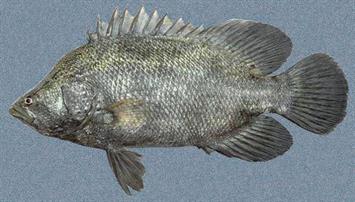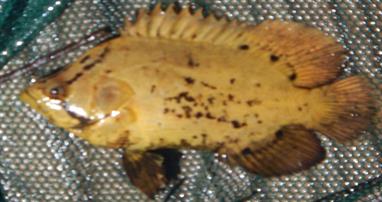



Lobotes surinamensis
| Ecological Descriptors |
||||
| Habitat | Size (cm) | Diet | Behaviour | Sex |
| EpiPel | to 110 | Pisc, Cru | I | F |
Description:
Rear dorsal and anal fins large, giving the appearance of 3 tails. Laterally compressed. Nape profile concave.
Adult: Generally greyish in colour, can vary to greenish-brown.
Juvenile: Lightly brown mottled on shades from cream to yellow-brown.
Ecology
A sluggish species that often floats on its side near the surface in the company of floating objects and occasionally drifts over reefs. Adults inhabit bays, muddy estuaries and even harbours. Juveniles may occur in floating Sargassum and mimic a floating leaf. It feeds on benthic crustaceans and small fish.
The maximum length is 110cm, but is common to about 80 cm.
Life Cycle:
For males, 50% maturity is reached at <29cm, and for females 50% maturity is attained at 48.5cm, which corresponds to approximately one year. Spawning lasts from approximately June through August. It is a multiple-spawning species with asynchronous developing oocytes. Fecundity is directly related to the length of the fish. Females lay ~ 400,000 eggs. Females spawn once every 3 to 5 days during spawning season, producing between 4.6 and 8 million eggs per spawning season
Rear dorsal and anal fins large, giving the appearance of 3 tails. Laterally compressed. Nape profile concave.
Adult: Generally greyish in colour, can vary to greenish-brown.
Juvenile: Lightly brown mottled on shades from cream to yellow-brown.
Ecology
A sluggish species that often floats on its side near the surface in the company of floating objects and occasionally drifts over reefs. Adults inhabit bays, muddy estuaries and even harbours. Juveniles may occur in floating Sargassum and mimic a floating leaf. It feeds on benthic crustaceans and small fish.
The maximum length is 110cm, but is common to about 80 cm.
Life Cycle:
For males, 50% maturity is reached at <29cm, and for females 50% maturity is attained at 48.5cm, which corresponds to approximately one year. Spawning lasts from approximately June through August. It is a multiple-spawning species with asynchronous developing oocytes. Fecundity is directly related to the length of the fish. Females lay ~ 400,000 eggs. Females spawn once every 3 to 5 days during spawning season, producing between 4.6 and 8 million eggs per spawning season
Atlantic Tripletail
Adult
Adult


Atlantic Tripletail
Juvenile
Juvenile

(C) Van Tassell & Robertson

354




